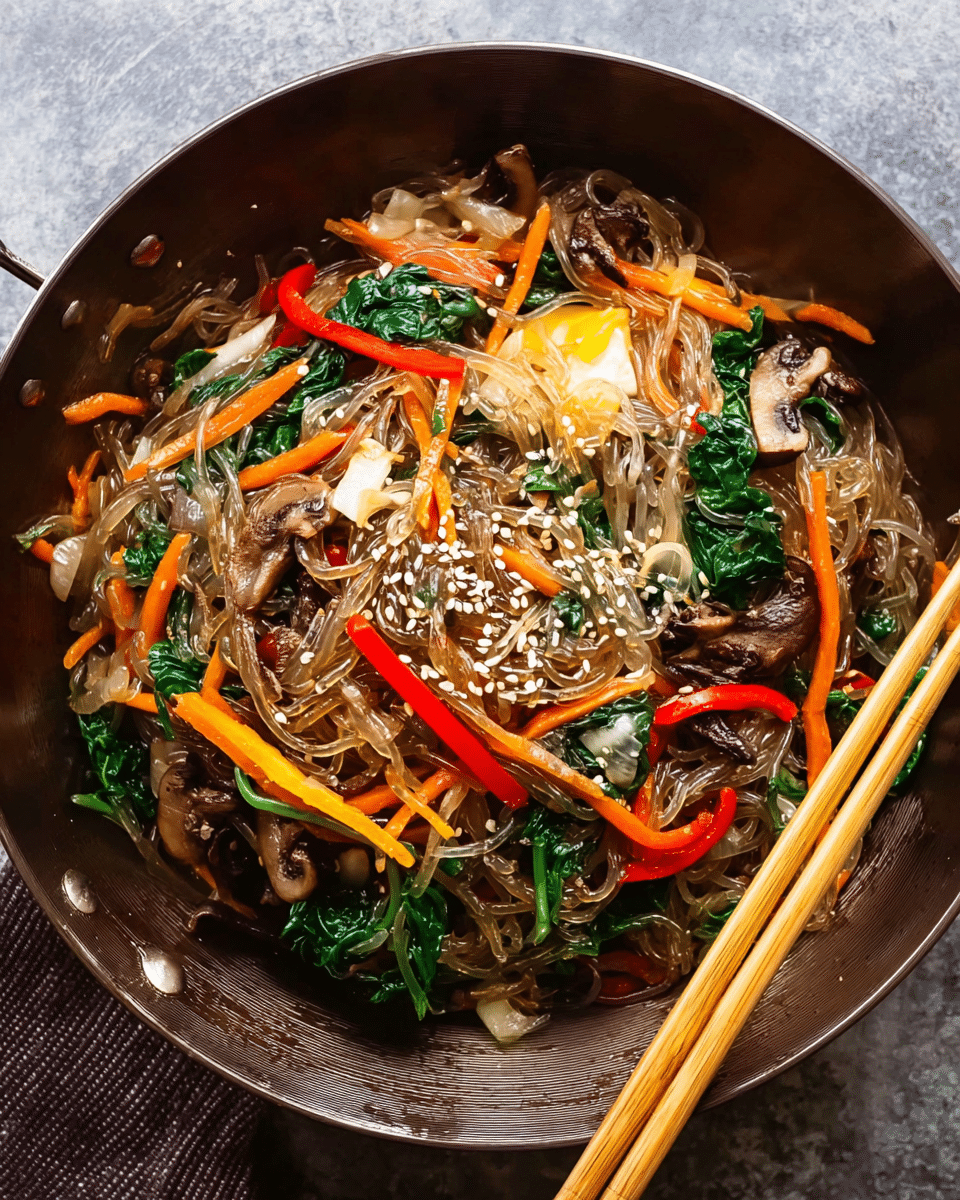Japchae Korean Noodles are a delightful combination of chewy glass noodles, vibrant vegetables, and a savory-sweet sauce. The dish is not only bursting with flavors but also with color, thanks to the variety of vegetables like spinach, mushrooms, and bell peppers.
This dish is incredibly versatile, allowing you to make it vegan, gluten-free, or add your favorite protein. It’s the perfect meal for any occasion, whether you’re hosting a dinner party or craving a quick yet comforting meal after a long day. The glossy noodles and vegetables, all tossed together in sesame oil, create a visually stunning dish that’s as beautiful as it is delicious.
Full recipe:
Ingredients:
-
200g (7 oz) sweet potato glass noodles (dangmyeon)
-
2 tablespoons vegetable oil
-
1 onion, thinly sliced
-
1 carrot, julienned
-
1 bell pepper, thinly sliced
-
2 cups spinach, chopped
-
1/2 cup shiitake mushrooms, sliced (or any mushroom of your choice)
-
2 cloves garlic, minced
-
2 tablespoons soy sauce
-
1 tablespoon sesame oil
-
1 tablespoon sugar
-
1 tablespoon rice vinegar
-
1 teaspoon sesame seeds
-
1/2 teaspoon ground black pepper
-
Salt to taste
-
2 eggs (optional, for garnish)
-
1 tablespoon sesame oil (for garnish)
Directions:
-
Cook the glass noodles according to package instructions, typically boiling them for about 6-7 minutes. Drain and rinse under cold water. Set aside.
-
In a large skillet or wok, heat vegetable oil over medium-high heat. Add the onion, carrot, bell pepper, spinach, and mushrooms. Stir-fry for about 3-4 minutes, or until the vegetables are tender but still crisp.
-
Add the garlic and stir-fry for another minute until fragrant.
-
Add the cooked noodles to the skillet. In a small bowl, mix soy sauce, sesame oil, sugar, rice vinegar, and black pepper. Pour this sauce over the noodles and vegetables. Toss everything together to ensure the noodles are evenly coated.
-
Stir-fry everything for 2-3 more minutes, making sure the noodles and vegetables are heated through and well combined.
-
If desired, fry the eggs in a separate pan to top the dish before serving.
-
Garnish with sesame seeds, extra sesame oil, and serve hot.
Prep Time: 15 minutes | Cooking Time: 15 minutes | Total Time: 30 minutes Kcal: 320 kcal | Servings: 3 servings
The Origins of Japchae
The origins of Japchae can be traced back to the 17th century during the Joseon Dynasty. According to Korean culinary history, Japchae was originally a dish served to royalty, created by a chef for King Gwanghaegun. The dish was made with stir-fried vegetables, meat, and noodles, but it wasn’t until the 20th century that Japchae became widely popular among the general public, especially after the development of the sweet potato starch noodles. The dish was initially prepared with a more elaborate mix of ingredients, but over time, it has evolved into the more accessible and everyday version that we enjoy today.
Japchae’s versatility is one of its greatest appeals. The recipe can be easily adapted to suit different dietary preferences or ingredient availability, making it a go-to meal for many. Whether you are looking for a vegetarian option or prefer to add meat such as beef, pork, or chicken, Japchae can be tailored to suit your personal tastes.
Key Ingredients and Their Role in Japchae
While Japchae’s core ingredients remain consistent, it’s the combination of these ingredients that makes the dish so special. The star of the dish is the sweet potato glass noodles, or dangmyeon, which provide a chewy texture that complements the crispy vegetables. These noodles are unique because they absorb the flavors of the sauce beautifully, making every bite an explosion of taste. The noodles are naturally gluten-free, which adds to Japchae’s popularity among those who follow gluten-free diets.
The vegetables used in Japchae contribute to the dish’s vibrant color and fresh flavor. Carrots, bell peppers, onions, spinach, and mushrooms are the most common vegetables found in Japchae. Each vegetable adds a different texture—crisp, tender, or juicy—creating a dynamic balance that makes the dish more enjoyable. The mushrooms, particularly shiitake, impart an earthy umami flavor that complements the savory soy sauce-based dressing.
Sesame oil is a key ingredient that brings a nutty richness to the dish, while soy sauce provides saltiness and depth of flavor. The addition of sugar gives the sauce a subtle sweetness, making the dish slightly sweet but not overpowering. Rice vinegar is sometimes added for a tangy kick that brightens up the dish, and sesame seeds are used for garnish to add an extra touch of flavor and crunch.
Cooking Tips for Perfect Japchae
Achieving the perfect Japchae requires a little attention to detail, but once you master the technique, it becomes a quick and easy dish to prepare. Here are a few tips to ensure your Japchae turns out perfectly every time:
-
Don’t overcook the noodles: The glass noodles should be cooked just until they are tender but still firm to the bite. Overcooking them can cause them to become mushy, which detracts from the dish’s texture.
-
Use high heat: Stir-frying Japchae requires high heat to get the best results. Using high heat ensures that the vegetables stay crisp and the noodles get a nice, slightly caramelized coating from the sauce.
-
Keep the vegetables crisp: The vegetables should be stir-fried just enough to soften slightly but still retain their crispness. This is essential for creating a balanced texture in the dish.
-
Use fresh sesame oil: The quality of sesame oil can significantly impact the flavor of the dish. Opt for toasted sesame oil for a richer, more pronounced flavor.
-
Customize to your liking: Japchae is highly customizable, and you can add your favorite vegetables or protein. Feel free to experiment with ingredients such as zucchini, sweet potato, or tofu for a unique twist.
-
Make ahead for convenience: Japchae is even better when it sits for a few hours or overnight, as the flavors have more time to meld together. Make a big batch in advance for easy leftovers or meal prep.
Health Benefits of Japchae
Japchae is not only delicious but also relatively healthy compared to other noodle dishes. It is naturally gluten-free, making it a good option for those with gluten sensitivities or celiac disease. Additionally, the dish is packed with vegetables, which provide essential vitamins, minerals, and fiber. The sweet potato noodles offer a good source of carbohydrates, while the addition of sesame oil provides healthy fats that support heart health.
Moreover, Japchae can easily be made vegan or vegetarian by omitting meat and using plant-based alternatives, making it a great choice for those following plant-based diets. The balance of vegetables, noodles, and the savory-sweet sauce makes Japchae a satisfying meal that can fuel your body while also pleasing your taste buds.
Serving Suggestions for Japchae
Japchae is often served as a side dish in Korean meals, alongside other banchan (small side dishes) such as kimchi, pickled vegetables, or steamed rice. However, it can easily be served as a main dish, especially if you add protein such as beef, chicken, or tofu. For a more traditional approach, Japchae is sometimes served at room temperature or chilled, making it perfect for summer gatherings or picnics.
Japchae pairs beautifully with a variety of beverages, from light teas to cold beers. If you’re looking to complement the meal with a beverage, consider serving it with traditional Korean drinks like barley tea (boricha) or even a glass of cold soju for a more festive occasion.
Japchae Variations and Adaptations
One of the best things about Japchae is its versatility. While the traditional recipe calls for vegetables like spinach, mushrooms, onions, carrots, and bell peppers, you can experiment with different vegetables to create your own version of Japchae. Zucchini, eggplant, and broccoli are great additions if you want to add more variety or use what you have on hand.
If you’re looking to add some protein to your Japchae, you can include thinly sliced beef, chicken, or even pork. Bulgogi, the marinated Korean beef, is a great option for adding flavor and richness to the dish. For a plant-based protein, tofu or tempeh are excellent choices that will soak up the delicious sauce just like meat.
If you’re following a gluten-free diet, make sure to use tamari instead of soy sauce, as tamari is a gluten-free version of soy sauce. You can also make the dish soy-free by using coconut aminos as a substitute for the soy sauce.
Why Japchae is a Crowd-Pleaser
Japchae is not only delicious, but it is also visually appealing. The colorful vegetables and glossy noodles create a beautiful dish that is perfect for serving at gatherings or family meals. Whether you’re hosting a special event or just looking for a comforting weeknight meal, Japchae will undoubtedly impress your guests.
The dish is easy to make in large batches, making it a great choice for potlucks, parties, or family dinners. Japchae is a flexible dish that can be served hot or at room temperature, which adds to its convenience for entertaining. Its natural sweetness and savory depth appeal to a wide range of palates, making it a crowd-pleaser for people of all ages and dietary preferences.
Conclusion
Japchae Korean Noodles are a delicious and versatile dish that brings together chewy glass noodles, fresh vegetables, and a savory-sweet sauce. With its rich history, vibrant flavors, and satisfying texture, Japchae is a perfect addition to any meal. Whether you’re preparing it for a special occasion or enjoying it as a quick and easy weeknight dinner, Japchae is sure to be a hit. By customizing the dish to your tastes and dietary preferences, you can make Japchae your own and enjoy this beloved Korean classic for years to come.






